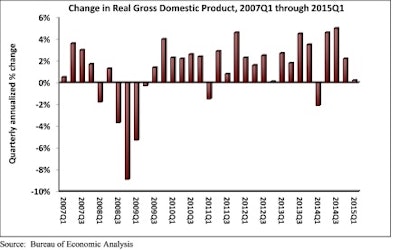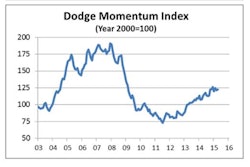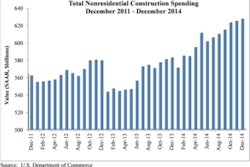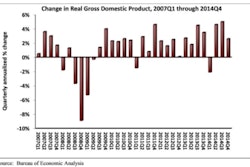
Nonresidential fixed investment fell 3.4 percent in the first quarter of 2015, after expanding 4.7 percent in the fourth quarter of 2014, according to the April 29 gross domestic product (GDP) report by the Bureau of Economic Analysis. Real GDP expanded just 0.2 percent, on a seasonally adjusted annualized rate, during the first quarter, following a 2.2 percent increase during the final quarter of 2014.
This represents the first quarter during which nonresidential fixed investment shrank since the first quarter of 2011. In fact, during five of the prior six quarters, nonresidential fixed investment expanded by more than 4 percent on an annualized basis. Even during the weather-impacted months of early 2014, nonresidential fixed investment continued to expand; however, energy prices were much higher then, prompting significant growth in the energy exploration, development and distribution sectors.
"Lower energy prices had an intense impact during the first quarter of 2015 and consumer spending was not enough to meaningfully offset the plummeting nonresidential fixed investment," said Associated Builders and Contractors Chief Economist Anirban Basu. "Investment in equipment inched up just 0.1 percent and, while investment in intellectual property products expanded 7.8 percent, the third component, investment in structures, fell 23.1 percent during this year's first quarter.
"While the nonresidential fixed investment number doesn't look great, contractors and others should not lose faith in the capacity of the U.S. economy to continue to expand," said Basu. "Investment in structures is volatile due to many circumstances. In addition, winter weather and the West Coast port slowdown didn't help and seasonal adjustments to the data are awkward.
"It's important to note that last year's first quarter was significantly worse for the overall economy," said Basu. "Eventually, consumer spending should pick up, and that will help things bounce back during the second and third quarters of the year. Despite lower gas prices and improving labor market conditions, spending on goods increased only 0.2 percent for the quarter. In addition, spending on services, groceries, and motor vehicles all slipped from their respective fourth quarter 2014 rates. We continue to hope that the Federal Reserve will begin increasing short-term rates in September, as the character of economic data recovers from a soft first quarter."
The following represent the first quarter performance of key segments:
- Personal consumption expenditures added 1.31 percent to GDP after contributing 2.98 percent in the fourth quarter.
- Spending on goods grew only 0.2 percent after a 4.8 percent increase in the fourth quarter.
- Real final sales of domestically produced output – minus changes in private inventories – decreased 0.5 percent for the first quarter, after a 2.3 percent increase in the fourth quarter.
- Federal government spending expanded 0.3 percent in the first quarter following a 7.3 percent decrease in the prior quarter.
- Non-defense spending expanded 1.9 percent after expanding 1.5 percent in the previous quarter.
- National defense spending fell 0.7 percent after growing 12.2 percent in the fourth quarter.
- State and local government spending fell 1.5 percent during the first quarter after growing 1.6 percent during the fourth quarter.
To view the previous GDP report, click here.

















